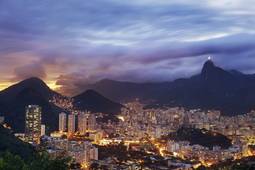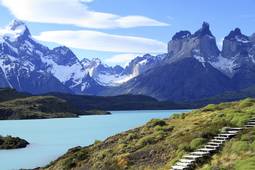Plan an amazing trip to Brazil
For me, Brazil is many things at once: an exceptional country where Afro-Brazilian culture, pulsing with the rhythm of samba and bossa nova, is only equalled by the typically wild landscape, remarkable beaches and famous carnivals. In this land of contrasts, materialism and mysticism coexist, where Christianity merges with the African origins of ‘candomblé’. All to the delight of the traveller who craves more as their journey continues.

Antoine's tips, Brazil expert
Best time to go to Brazil
The climate in Brazil is mixed. This multifaceted country has 5 different climatic regions. To make the most of the whole of Brazil, the most pleasant time to visit is from June to September.
My favourite month: APRIL because the weather is fine, the temperature is lower and more agreeable, the sea is warm and, as it is the beginning of the low season, there are fewer crowds. Of course, this is the best month to visit Rio. Brazil is very large with seasonal differences in the north and north-east.
What to see and what to do in Brazil
Antoine answers your most frequently asked questions
Day 1 - 3: RIO de JANEIRO (Visit the Ipanema and Copacabana beaches for swimming; visit the Sugarloaf Mountain.)
Day 2 - Visits to the statue of Christ the Redeemer, the Centro Historico and Santa Teresa.
Day 3 - Guided tour of a favela (Vidigal, Rocinha, Babilonia and Chapeu Mangueira or Santa Marta) and a walk in Tijuca forest or the Botanical Garden.
An evening of samba and feijoada organised by one of the local samba schools.
Day 4 - 6: Costa Verde
Allow 4.5 hours by bus or private transport from Rio to Paraty. Arrive mid-morning
Visit the town and its colonial gems followed by a boat trip or a trip by jeep through the tropical Atlantic forest.
Day 5 and 6 Ilha Grande: By bus or private transport and speed boat, allow 2.5 hours from Paraty, leaving late morning to arrive mid-afternoon in Ilha Grande. For a lazy, nature-filled trip, enjoy the many beaches (including the famous Lopez Mendez beach) hiking in the Atlantic forest with their waterfalls and natural pools, and boat tours of the island with opportunities for snorkeling and deep-sea diving.
Day 7 - Day 9: Iguazu Falls Natural Park
Jour 7 : Départ début de matinée d’Ilha Grande (speed boat) + bus ou transport privé.
Early morning, leave Ilha Grandé by speed boat and bus or by private transport. Fly from Rio to Foz do Iguaçu to arrive in the afternoon. Try to find accommodation in the more attractive Argentinian side.
Day 8: Excursion to the park’s Argentinian sector, which is much larger than the Brazilian side. A whole day is required to complete the lower circuit. For the upper circuit, take the small train to the Devil’s Throat (the highest point of the falls)
Day 9: Visit to the park’s Brazilian zone. The half-day guided tour begins with the bus which takes you to the foot of the falls. The rest of the circuit is completed on foot. Take the opportunity to to visit the bird sanctuary at the entrance to the falls park. The 2 or 3 hour walk through huge aviaries, among parrots toucans and other multi-coloured birds of Brazil is amazing.
Day 10 - 14 Bahia State
Day 10:Foz do Iguaçu to Salvador via São Paulo (approximately 4.5 hour flight)
Day 11: Visit the historic centre of Salvador. Le Pelourinho is classified as a UNESCO world heritage site and, along with Paraty, considered a one of the brightest jewels of the colonial era. Spend a day strolling through the alleys and pedestrianised streets of Largo de Pelourinho, visit the house of the writer Jorge Amado, the Terreiro de Jesus, the Mosteiro São Bento, the Praça da Sé, the Ladeiro do Carmo , Largo Cruzeiro São Francisco. Finally, take the Lacerda elevator to visit the Mercado Modeloba.
Day 12: In the morning, visit the Bonfim neighbourhood and its magnificent church before taking the catamaran from Terminal Maritimo (opposite the Modelo market) and head for the island of Moro de São Paulo (warning: the last departure is at 14:30 and the journey takes around 2 hours). If you have the time, make the most of the beach before strolling through the car free streets of the village.
Day 13: There are 4 beaches in Morro de São Paulo. They are accessible on foot and you can stop where you choose (for me it’s always the furthest, remotest and wildest beach). If you want to explore, you can follow the coastline to the fishing village of Gamboa, past the clay cliffs where it’s good to take a mud bath before rinsing off in the sea.
Day 14: Discover the island of Boipeda. Take a round trip by boat from Morro de São Paulo to discover the island of Boipeda. It is wilder and greener than its neighbour and has magnificent beaches.
With 7,500 km of Atlantic coastline from the extreme north (Rio Grande do Norte) to the extreme south (Rio Grande do Sul), Brazil has the 16th longest coastline of the world. With famous beaches the length of the Costa Verde - Jericocoara in the North East and those around Florianópolis in the south. And in Bahia state, of course, the Linha Verde and Costa dos Coquieros to the south of Salvador and, to the north, beautiful beaches around Trancoso (near Porto Seguro) with the island of Caraiva further off the beaten track.
The roads are generally bad in Brazil, especially the north, north east and central areas. Roads in the south east and south are better, especially those which connect the major urban centres. It is therefore necessary to pay attention when driving, particularly to the impressively sized potholes which dot Brazilian roads. Brazilian driving also leaves much to be desired, with frequent disregard for the rules of the road. So, drive with extreme caution and avoid driving at night. Finally, given the high cost of insurance, around 30 - 35% of Brazilians are uninsured and will flee the scene of an accident if they can.
Carnival do Rio in February (also in Salvador, Recife and Olinda among others)
2 million people dressed in white admire magnificent fireworks set off from Copocabana beach each New Year’s Eve in Rio.
Festa de lemanjá is Brazil’s most important festival, dedicated to the goddess of the sea (one of the most important Orixas of the candomblé tradition). Taking place on the 2nd February, a huge crowd of the faithful and spectators descends on Rio Vermelho beach.
Oktoberfest in Blumeneau (Santa Caterina state) in October takes place in the most German town in Brazil. It’s a party which attracts huge numbers to giant marquees where Bavarian bands teach the public to dance. The beer flows for about 17 days of intense partying.
The last weekend of June brings together tens of thousands of people from all over Brazil to witness the Garantido and Caprichoso traditional parades with fancy dress, sequins and rhythmic music (also held in São Luis).
The Festas Juninas are held throughout the country in June in honour of St. Anthony, St. John and St. Peter with bonfires, traditional Forrò dancing and participants dressed as gaucho.
This question is as large as the huge forest crossed by the longest river in the world. Take an Amazon cruise, the cruise ships stopping for excursions in smaller boats, fishing for piranha and guided walks through the forest with wildlife experts. You can also opt for a hotel lodge in the middle of the forest, generally located on a tributary, where you can be guided to discover the abundance of flora and fauna, either hiking or by canoe, with some offering tree climbing to allow you to discover the tree canopy at around 30 metres. Or, for those who want real authenticity, share a day in the life of the Caboclos, inhabitants of the region (indigenous and Portuguese mestizos), staying in a village and sharing meals with a family that will help you discover the forest.
The statue of Christ the Redeemer
Sugarloaf Mountain
The Selaron Steps
The monastery of St. Benedict, a treasure trove of flamboyant baroque
A samba school (Mangueira, Beija Flor…)
Brazilian food culture is inspired by Indian, African, Portuguese, Slavic, Italian, Jewish and Arabic cuisine. Nevertheless, each main dish is generally served with rice (arroz) or beans (feijão), or both. The Brazilian national dish is feijoada, a stew of beans and pork (belly, trotters, tail and ears), smoked sausage, garlic and onions. In Minas Gerais, the bean puree is prepared with rice and green cabbage before being served with pork chops, or breaded bananas. In Nordeste, mashed cassava is used in the dish Carne Seca. Brazilian couscous, meanwhile, is a tapioca cake with coconut and covered with condensed milk while empadão is a pie filled with shrimp. Other unmissable dishes include barreado, buchada de carneiro, churrasco and pernil assado.
Souvenirs of Brazil range from cachaça (sugarcane brandy) to branded flip flops, through sculptures, hammocks, and embroidered leather in the north-east and precious stones from Minas Gerais.
- Feeling unsafe in certain places, linked to the significant levels of poverty
- The great distances required to discover each unmissable area of the country
- Carnaval in Rio de Janeiro
- Copocabana and Ipanema beaches
- The Iguazu Falls
- The Amazon rainforest
- The UNESCO world heritage sites




























